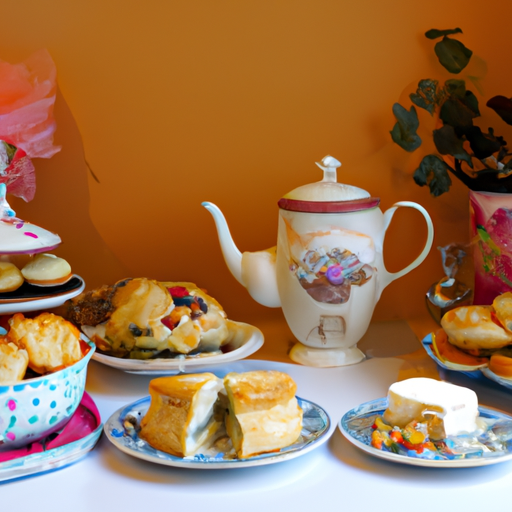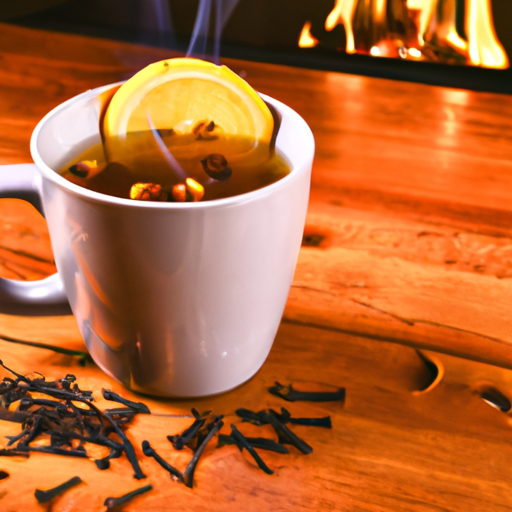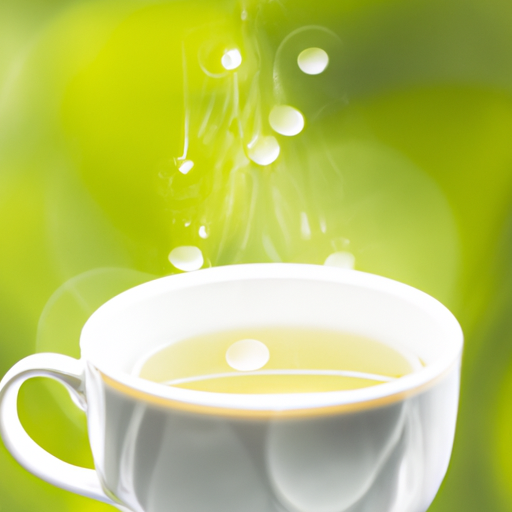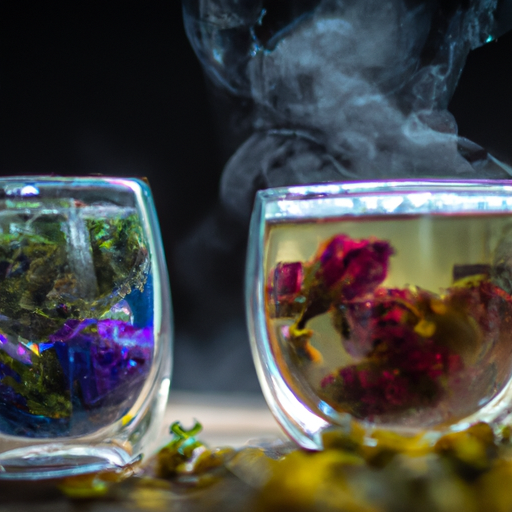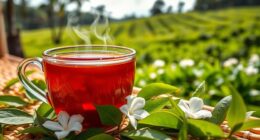Imagine yourself in the quaint English countryside, enveloped in grace and heritage. The atmosphere is infused with the delightful scent of freshly brewed tea, as you nestle into a snug environment, prepared to partake in a classic tradition.
Welcome to the world of Afternoon Tea and High Tea, two distinct traditions that have captured the hearts of tea enthusiasts for generations.
In this article, we will unravel the fascinating differences between these two cherished traditions and explore their origins and etiquette.
From the delicate savories and delectable scones to the rich flavors of hearty dishes, we will delve into the menus that define each experience.
And for those who wish to recreate the magic in the comfort of their own homes, we will provide a guide on how to host your own Afternoon Tea gathering.
So, whether you are looking to immerse yourself in regal refinement or savor the hearty comforts of a working-class meal, join me as we embark on a journey through the timeless and delightful English tradition of Afternoon Tea and High Tea.
Key Takeaways
- Afternoon Tea originated in the 1840s in Britain as a mid-afternoon meal before dinner and is known for its calm and conversation.
- High Tea, often mistakenly referred to as Afternoon Tea, is actually a working-class family evening meal consisting of hearty dishes.
- Afternoon Tea includes a three-course meal of savories, scones, and sweets, served on low tables and with a variety of specialty teas.
- Afternoon Tea is a cherished English tradition that can be enjoyed in tea rooms or recreated at home with recipes and gourmet tea options.
What is it?
Afternoon Tea is a cherished English tradition that I love because it allows me to indulge in a moment of relaxation and enjoyment with finger sandwiches, scones with clotted cream and jam, and sweet pastries, all served on a three-tiered tray with pots of tea and a variety of gourmet tea options.
It is more than just a meal; it is a cultural experience that has deep roots in British history. Afternoon Tea originated as a mid-afternoon meal for the upper class, while High Tea was a working-class family evening meal.
Today, Afternoon Tea has evolved and can be enjoyed by people from all walks of life. Modern adaptations of Afternoon Tea include themed tea parties, such as those inspired by popular period shows like Downton Abbey and Bridgerton. It is a delightful way to celebrate special occasions or simply enjoy a moment of tranquility in the midst of our busy lives.
Origins and Etiquette
Origins and etiquette of this cultural practice involve the Duchess of Bedford and the formalization of tea receptions by Queen Victoria.
Afternoon Tea has a rich history that dates back to the 1840s in Britain. It all started with the Duchess of Bedford, who would order tea and cakes to alleviate her hunger in the late afternoon. This simple act quickly became a popular social event among high society ladies and later spread to other socioeconomic groups.
Queen Victoria’s engagement in Afternoon Tea made it a formal occasion known as tea receptions. Today, Afternoon Tea is a cherished English tradition that embraces the lost tea fashion. It is a meal that includes finger sandwiches, scones with clotted cream and jam, and sweet pastries.
The etiquette of Afternoon Tea involves serving tea first, followed by a soup course and then three courses of savories, scones, and sweets. The tea is served in a pot, and guests can choose from a variety of teas. Tea sandwiches are small and crustless, featuring classics like cucumber, egg salad, and smoked salmon. Scones are served with clotted cream and jam, and guests should use a knife to spread the cream and jam onto small pieces of the scone. Sweets, such as mini pastries, should be placed on a plate before eating.
Afternoon Tea is more than a meal; it is a moment of relaxation and enjoyment. It is a way to celebrate special events like birthdays and pre-wedding parties. Whether enjoyed at a small hotel or recreated at home with recipes and specialty teas, Afternoon Tea is a way to experience British culture and indulge in a moment of tradition and elegance.
Afternoon Tea Menu
Indulging in the delectable array of savory sandwiches, warm scones, and exquisite pastries during this elegant affair is like stepping into a culinary paradise. The afternoon tea menu offers a delightful selection of treats that are sure to satisfy any palate.
From delicate finger sandwiches filled with cucumber, egg salad, and smoked salmon to freshly baked scones served with clotted cream and jam, every bite is a heavenly experience.
The sweet pastries, like the classic Battenberg Cake and Bakewell Tart, add a touch of indulgence to the menu. If you’re feeling adventurous, you can recreate these delectable treats at home with afternoon tea recipes from The Official Downton Abbey Afternoon Tea Cookbook.
For the ultimate experience, visit the best tea houses or small hotels known for their exquisite afternoon tea, where you can savor these delectable treats in a charming and regal setting.
Recreating the Experience at Home
To recreate the experience at home, I can gather the necessary ingredients and follow the recipes from The Official Downton Abbey Afternoon Tea Cookbook. This cookbook is a treasure trove of delicious treats, including Battenberg Cake, Bakewell Tart, cream scones, and tea sandwiches. It provides step-by-step instructions that make it easy to create an authentic Afternoon Tea experience in the comfort of my own home.
In addition to the recipes, there are also some tips for hosting a successful afternoon tea at home. It’s important to set the table with fine china and elegant tea accessories, such as a teapot, tea strainer, and tea cups. Using a three-tiered serving tray adds a touch of elegance to the presentation of the tea treats. I can also create a cozy atmosphere by lighting some scented candles and playing soft music in the background.
With these simple touches, I can bring the charm and relaxation of Afternoon Tea into my own home.
Frequently Asked Questions
What is the significance of serving tea sandwiches without crusts during Afternoon Tea?
Crustless tea sandwiches are a symbol of elegance and refinement in afternoon tea. They showcase the attention to detail and adherence to proper tea etiquette, adding to the overall sophistication of the experience.
How did Queen Victoria’s engagement in Afternoon Tea impact its popularity and formality?
Queen Victoria’s engagement in Afternoon Tea elevated its status and popularity. Her influence on tea culture and social status transformed it into a formal occasion known as tea receptions, solidifying its place as a cherished English tradition.
What are some popular tea options to pair with Afternoon Tea?
Popular tea options for afternoon tea include Earl Grey, English Breakfast, and Darjeeling. To properly brew tea for afternoon tea, use loose tea leaves or tea bags, steep for the recommended time, and serve with milk and sugar if desired.
Is Afternoon Tea primarily enjoyed by older generations or is it becoming popular among younger adults as well?
Afternoon tea is not just for older generations; it has become a trendy and popular choice among younger adults. It is a cherished tradition that offers a moment of relaxation and enjoyment in modern culture. Afternoon tea trends are on the rise!
Are there any specific traditions or customs associated with Afternoon Tea that guests should be aware of?
When it comes to afternoon tea etiquette, there are a few traditions to keep in mind. Proper tea pouring techniques involve serving tea first, followed by a soup course, and then three courses of savories, scones, and sweets. Guests should also use a knife to spread clotted cream and jam onto their scones.
Conclusion
In conclusion, the distinction between Afternoon Tea and High Tea is crucial to understand. Afternoon Tea is a refined and elegant tradition that originated in the 1840s. It is a delightful experience enjoyed at exclusive tea houses and hotels, featuring a three-course meal of savories, scones, and sweets.
On the other hand, High Tea is a more substantial working-class meal served in the evening, with hearty dishes like meat and vegetables.
So, if you’re looking to recreate a royal experience at home, grab a copy of The Official Downton Abbey Afternoon Tea Cookbook and transport yourself to a bygone era of elegance and grace. It’s time to sip tea like a true aristocrat!

